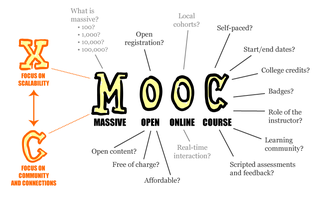
A textbook is a book containing a comprehensive compilation of content in a branch of study with the intention of explaining it. Textbooks are produced to meet the needs of educators, usually at educational institutions. Schoolbooks are textbooks and other books used in schools. Today, many textbooks are published in both print and digital formats.
Blended learning or hybrid learning, also known as technology-mediated instruction, web-enhanced instruction, or mixed-mode instruction, is an approach to education that combines online educational materials and opportunities for interaction online with physical place-based classroom methods.

Open educational resources (OER) are teaching, learning, and research materials intentionally created and licensed to be free for the end user to own, share, and in most cases, modify. The term "OER" describes publicly accessible materials and resources for any user to use, re-mix, improve, and redistribute under some licenses. These are designed to reduce accessibility barriers by implementing best practices in teaching and to be adapted for local unique contexts.
A learning management system (LMS) or virtual learning environment (VLE) is a software application for the administration, documentation, tracking, reporting, automation, and delivery of educational courses, training programs, materials or learning and development programs. The learning management system concept emerged directly from e-Learning. Learning management systems make up the largest segment of the learning system market. The first introduction of the LMS was in the late 1990s. LMSs have been adopted by almost all higher education institutions in the English-speaking world. Learning management systems have faced a massive growth in usage due to the emphasis on remote learning during the COVID-19 pandemic.
RateMyTeachers.com (RMT) is a review site for rating K-12 and college teachers and courses. According to its website, its purpose is to help answer a single question: "what do I as a student need to know to maximize my chance of success in a given class?" As of April 2010, over eleven million teachers have been rated on the website.
A virtual university provides higher education programs through electronic media, typically the Internet. Some are bricks-and-mortar institutions that provide online learning as part of their extended university courses while others solely offer online courses. They are regarded as a form of distance education. The goal of virtual universities is to provide access to the part of the population who would not be able to attend a physical campus, for reasons such as distance—in which students live too far from a physical campus to attend regular classes; and the need for flexibility—some students need the flexibility to study at home whenever it is convenient for them to do so.

Western Governors University (WGU) is a private, non-profit online university based in Millcreek, Utah, United States. The university uses an online competency-based learning model, providing advanced education for working professionals. Degrees awarded by WGU are accredited by the Northwest Commission on Colleges and Universities (NWCCU). The university was founded by 19 U.S. governors in 1997 after the idea was formulated at a 1995 meeting of the Western Governors Association to expand education offerings to the internet.
A course evaluation is a paper or electronic questionnaire, which requires a written or selected response answer to a series of questions in order to evaluate the instruction of a given course. The term may also refer to the completed survey form or a summary of responses to questionnaires.
Formative assessment, formative evaluation, formative feedback, or assessment for learning, including diagnostic testing, is a range of formal and informal assessment procedures conducted by teachers during the learning process in order to modify teaching and learning activities to improve student attainment. The goal of a formative assessment is to monitor student learning to provide ongoing feedback that can help students identify their strengths and weaknesses and target areas that need work. It also helps faculty recognize where students are struggling and address problems immediately. It typically involves qualitative feedback for both student and teacher that focuses on the details of content and performance. It is commonly contrasted with summative assessment, which seeks to monitor educational outcomes, often for purposes of external accountability.
A review site is a website on which reviews can be posted about people, businesses, products, or services. These sites may use Web 2.0 techniques to gather reviews from site users or may employ professional writers to author reviews on the topic of concern for the site.
The system of education in Iceland is divided in four levels: playschool, compulsory, upper secondary and higher, and is similar to that of other Nordic countries. Education is mandatory for children aged 6–16. Most institutions are funded by the state; there are very few private schools in the country. Iceland is a country with gymnasia.
Assessment in computer-supported collaborative learning (CSCL) environments is a subject of interest to educators and researchers. The assessment tools utilized in computer-supported collaborative learning settings are used to measure groups' knowledge learning processes, the quality of groups' products and individuals' collaborative learning skills.

The São Paulo State Technological Colleges are public institutions of higher education maintained by the State Center of Technological Education (CEETEPS). FATECs are important Brazilian institutions of higher education, being pioneers in the graduation of technologists. They are located in several cities of the São Paulo state, with four campuses in the capital, and several other units in the metropolitan region of São Paulo, countryside and seashore.

A Virtual Learning Environment (VLE) is a system specifically designed to facilitate the management of educational courses by teachers for their students. It predominantly relies on computer hardware and software, enabling distance learning. In North America, this concept is commonly denoted as a "Learning Management System" (LMS).

Academic standards are the benchmarks of quality and excellence in education such as the rigour of curricula and the difficulty of examinations. The creation of universal academic standards requires agreement on rubrics, criteria or other systems of coding academic achievement. At colleges and universities, faculty are under increasing pressure from administrators to award students good marks and grades without regard for those students' actual abilities, both to keep those students in school paying tuition and to boost the schools' graduation rates. Students often use course evaluations to criticize any instructor who they feel has been making the course too difficult, even if an objective evaluation would show that the course has been too easy. It is very difficult to find a direct correlation between the quality of the course and the outcome of the course evaluations.
Online communication between home and school is the use of digital telecommunication to convey information and ideas between teachers, students, parents, and school administrators. As the use of e-mail and the internet becomes even more widespread, these tools become more valuable and useful in education for the purposes of increasing learning for students, and facilitating conversations between students, parents, and schools.

A massive open online course or an open online course is an online course aimed at unlimited participation and open access via the Web. In addition to traditional course materials, such as filmed lectures, readings, and problem sets, many MOOCs provide interactive courses with user forums or social media discussions to support community interactions among students, professors, and teaching assistants (TAs), as well as immediate feedback to quick quizzes and assignments. MOOCs are a widely researched development in distance education, first introduced in 2008, that emerged as a popular mode of learning in 2012, a year called the "Year of the MOOC".
StraighterLine is a U.S. educational company that offers low-price, online higher education courses that are equivalent to general courses required for a bachelor's degree. The American Council On Education’s College Credit Recommendation Service has evaluated and recommended college credit for StraighterLine courses. The company is itself unaccredited, but has over 150 partnerships with accredited colleges and universities that accept its courses for credit.
A student bill of rights is a document that outlines beliefs or regulations regarding student rights, typically adopted by a student group, school, or government. These documents can be policies, laws, or statements of belief.

Kahoot! is a Norwegian online game-based learning platform. It has learning games, also known as "kahoots", which are user-generated multiple-choice quizzes that can be accessed via a web browser or the Kahoot! app.







